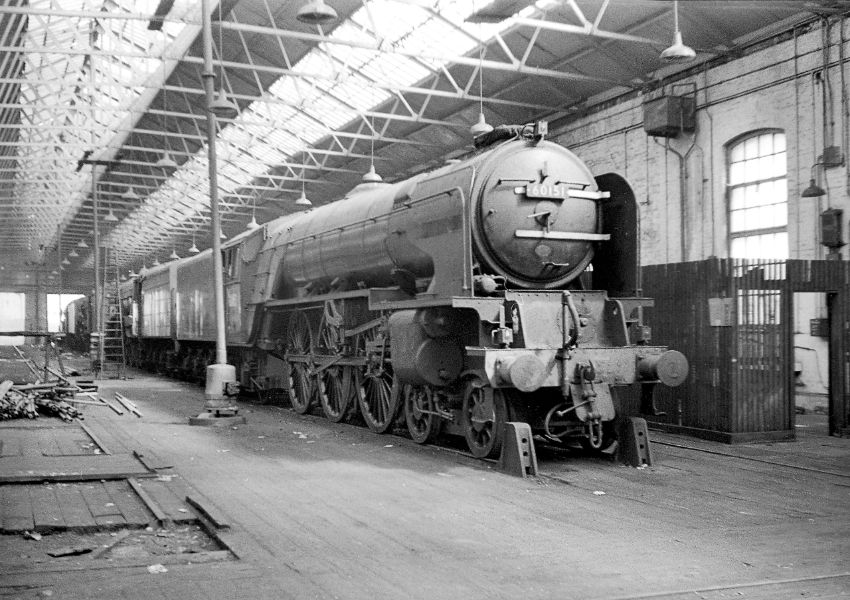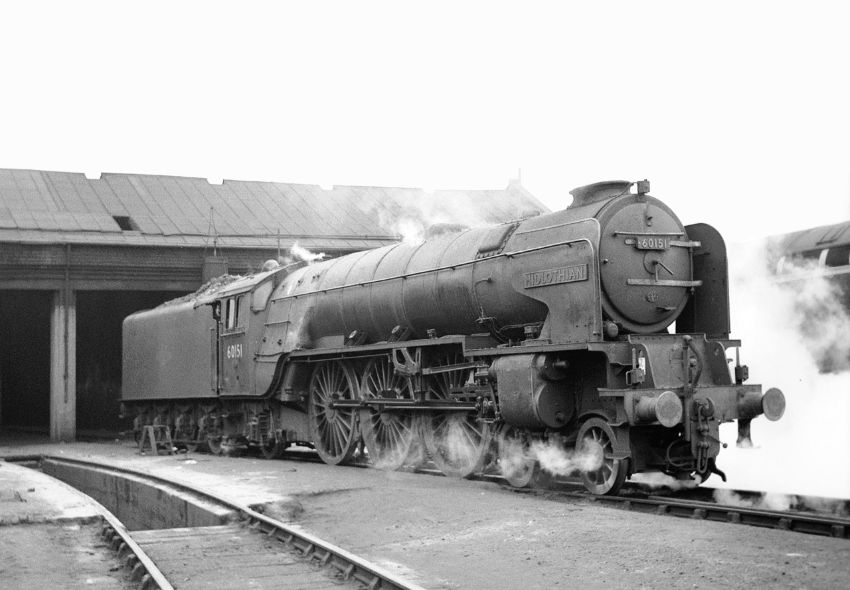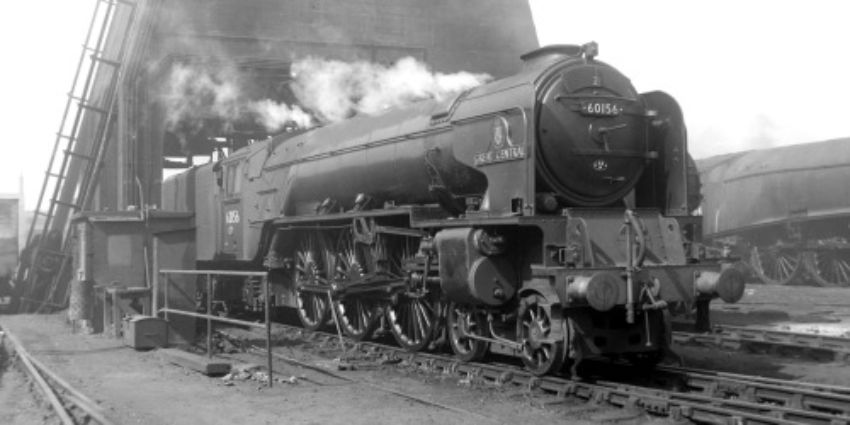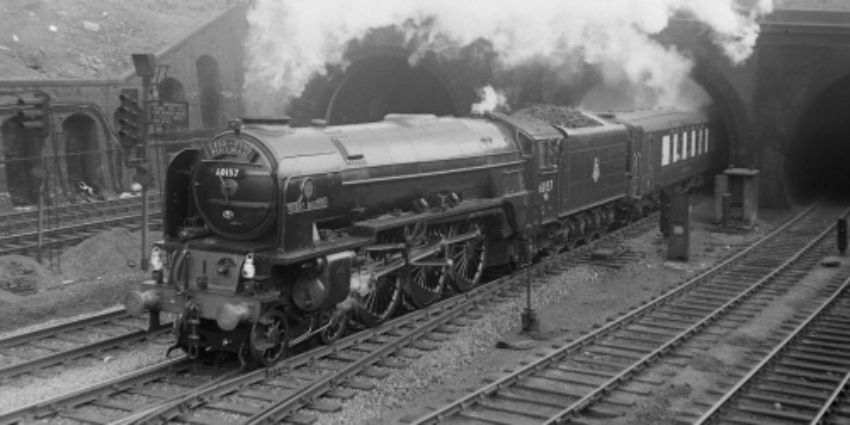Modifications – The Peppercorn Class A1s were built in four batches ordered from 1945 to 1948, Doncaster being responsible for 26 of the class, Darlington for the construction of 23, they entered service during 1948 and 1949 carrying a Diagram 118 boiler and rather plain, sheet metal chimneys (only No. 60158 was fitted with a cast iron chimney from the outset). The origin of individual members of the class could be divined by the use of snap-head rivets on the non-corridor tender (Doncaster) or the flush variety (Darlington). Almost as soon as they were in traffic small modifications and changes started to be applied to the class, some of which will be covered here.
Apart from the fitting of five locomotives with roller bearings at the outset (Nos. 60153-7) modifications to the running gear saw improved lubrication applied to the middle big end and October 1952 saw the fitting of Nos. 60122, 60123 and 60125 equipped with a Swindon type forked inside connecting rod incorporating a clip and cotter to secure the bearing. Although initially fitted with Diagram 118 boilers, overhauls saw these occasionally being changed for Thompson Diagram 117 boilers which did not have ‘banjo’ type steam collectors of the Gresley pattern although the A1s still had the banjo dome cover fitted over these (apart from No. 60153 which did wear a small dome cover whist carrying a Diagram 117 boiler) although the cover was further forward that on the Diagram 117 type. From 1950 onward the whole class were equipped with the more aesthetically pleasing cast iron chimneys and the vacuum ejectors were fitted with silencers since in their original form they were very noisy and blamed for drowning out station announcements!
Like the Thompson B1s, the Peppercorn A1s were all fitted with electric lighting and a Stone’s turbo-generator to provide power for these, although early experiments with discs to denote train type were quickly abandoned in favour of traditional oil lamps to supplement the electric lights which carried brackets for this purpose from the start. One source of constant change was the position of the lamp bracket and, in consequence the handrail, on the smokebox door. Early experience showed that train headboards sat to high and obscured the top electric light and so the bracket was moved down and the smokebox numberplate relocated to straddle the top hinge of the door, in some cases the bracket was moved even lower requiring a bifurcated handrail – this led to a pattern of constant change in positions according to boiler swaps!


No. 60151 Midlothian illustrates two types of smokebox door furniture – Bill Reed & Dick Manton
Some members of the class entered traffic equipped with Flaman speed recorders, Doncaster-built Nos. 60114-29 all being so fitted from the outset but only Nos. 60130, 60133, 60134 and 60136 of the Darlington batch carried them. The Flaman gear was removed during 1950-1 although some of the engines retained the brackets for a number of years. In due course the entire class was fitted with Smith-Stone speedometers driven off the left-hand , rear driving wheel. Mention of speedometers is a logical place to cover the involvement of the class in the development of the British Railways system of automatic train control: Although the Great Western Railway had enjoyed the enhanced safety of an ATC system for many year the other railway of the ‘Big Four’ had not reached a consensus and work on its development was over-shadowed by WW2. The Peppercorn A1s were chosen to take part in trials of the Hudd system with No. 60149 fitted with the equipment for trials in 1949 although these trials seem to have been inconclusive and many of the A1s subsequently fitted with it had lost the apparatus by 1952… alas, the terrible triple collision at Harrow & Wealdstone that October brought the issue sharply back into focus and No. 60130 was fitted with a modified version of the equipment immediately afterwards. Trials to refine the system eventually led to the development and deployment of the Automatic Warning System from 1959 onward, all 49 members of the class being so-fitted in due course.
Most of the class appeared from their respective works wearing LNER apple green with black and white lining but bearing the words ‘BRITISH RAILWAYS’ in Gill Sans lettering, however, the last three to emerge from Doncaster were out-shopped in the new British Railways blue livery with the early emblem (a lion straddling a wheel) on the tender with black and white lining , a change applied to the rest of the class as they went through the works in due course. The blue livery didn’t last very long and by February 1953 the whole class had been repainted in express passenger green with black and orange lining, No. 60130 being the last locomotive to be thus transformed. The final change to the livery carried by the A1s was the adoption of the later crest which was progressively applied to individual locomotives during later works’ visits. Full details of how these changes affected individual class members can be found here.
In Traffic – The Peppercorn class A1s worked principal expresses on the East Coast Main Line from 1948 until the end of steam on that route. They hauled trains of up to 600 tons at an average of 60mph; 100 mph was not unknown and on one occasion an A1 produced an estimated 2,400 drawbar horsepower. Five of the original A1s were built with roller bearings on all axles, and the class turned in reliability figures better than those of any other express passenger steam locomotive in the country. Peter Townend, former King’s Cross shedmaster, takes up the story:
“The 49 A1 class locomotives were built at Doncaster and Darlington in 1948-49, five numbers 60153-57 were fitted with roller bearing axleboxes. The 49 locomotives were initially allocated widely to the principal depots on the East Coast main line, including five at Haymarket. Further south the Green Arrows were quickly supplanted on main line express work by the more powerful A1 class engines.
By the time I was appointed Shedmaster at King’s Cross in 1956, the A1s had been concentrated at certain depots in the Eastern Region, Copley Hill and Grantham particularly used A1s on all their express work with excellent timekeeping but King’s Cross was firmly A4 territory with 19 engines allocated and about a dozen A3s. However in 1956-57 the main line diagrammed workings were changed to eliminate locomotive changes en route and in consequence the Top Shed lodging turns to Newcastle were increased. As a result 12 A1s were transferred to the King’s Cross roster. It was considered at the time that allocating footplate crews to their own locomotives on a regular basis produced the best results rather than working the engines through with crew changes en route. A number of A1s were therefore allocated to drivers and firemen at King’s Cross who worked their own engine through to Newcastle and brought them back the next day after lodging in an hotel. The A1s proved to be very powerful locomotives and could haul anything required with ease including a down freight working No. 266 to Newcastle with a short break at York. This working was transformed by putting the working into the King’s Cross top link.
During their time at King’s Cross, although not popular with many of the crews because the riding of the A1s was not equal to that of the A4, the miles run per four weekly period nevertheless averaged about a third more for the A1s. The two sets of men who were allocated roller bearing engine No. 60156 retained this as their regular engine all the time it was allocated to Top Shed; they knew it was an exceptionally reliable locomotive.

No. 60156 Great Central at Top Shed coaling plant, Circa 1957 – Peter Townend
Generally the casualties which did occur were different to those of the Gresley engines apart from injectors which were a trouble for a time with both types. Two very serious delays come to mind, which occurred with A1s and injectors. One of these failed on ‘The Flying Scotsman’ at New Barnet in the down direction and one again on the same train in the up direction at Hatfield, which was reported in the national press. Both required the fire to be thrown out. These failures were not due to the design of the A1 or A4 for that matter or the injectors themselves but to the fitting of a BR type strum box underneath the well of the tender in Doncaster Plant which King’s Cross was unaware of . The water feed was through a single orifice to both injectors which was proved to be inadequate.
Although not a serious problem the inside valve gear fitted to the A1 did not prove to be as reliable in service as the Gresley conjugated fitted to the A3, A4 and V2 locomotives. Overheated driving axleboxes were virtually unknown on the A1 class whereas the Gresley engines occasionally ran the right driving axlebox hot. The most serious casualties which the A1s suffered were on at least two occasions in the Eastern Region when all the coupling and connecting rods were bent due to serious slipping.
A problem which was reported in correspondence with a Member of Parliament who observed bolts missing from the smokebox saddle as he walked past the engine at King’s Cross. This had occurred on the Thompson Pacifics but was unknown on the Gresley Pacifics. It was thought to be due to expansion or perhaps flexing at the front end but it was decided to strengthen the smokebox by fitting a steel ring around the back of the smokebox and a thick steel plate to the inside of the smokebox saddle.
Despite the difficulties mentioned above the A1 class were light on maintenance and the most reliable of the Pacifics at the time at King’s Cross. When a number of classes of locomotives were costed by British Railways in the early 1950’s, the total maintenance cost in pence per mile for the A1s was considerably lower than that of any other class 8 locomotive. Higher mileages were generally achieved between classified repairs. One of the roller bearing engines at King’s Cross No. 60157 attained 197,000 miles, the highest of any King’s Cross engines.

No. 60157 exiting Gasworks Tunnel with Tees-Tyne Pullman, 30th May 1957 – Peter Townend
The A1s were fitted with the Kylchap double exhaust system when built and with the short boiler barrel the engines steamed so freely that liberties could be taken by the fireman which would have caused serious difficulties with single blast-pipe locomotives. When tested the A1s showed their economy in coal and water consumption on heavy 500 to 600 ton trains for which they were designed to haul at speeds of 50 to 60 mph. respectively. The maximum power output was recorded at over 2000dhp. at around 40% cut off and speeds of 55-60 mph.
Various performances and lost time recovery were reported in the railway press by C.J.Allen and perhaps the finest was when A1 No. 60140 was substituted for a failed diesel locomotive at York and the King’s Cross driver Dick Turner who was never late if he could help it, recovered the 26 minutes delay to London averaging 71.4 mph. with nine coaches 308 tons tare. The most important feature of the work of the A1 class was however recorded by another regular traveller between Leeds and London who timed every run and it was the A1 locomotives which were the most consistently on time.”
We have an extensive archive of historical photographs of A1s in service (such as those by Peter Townend used in the individual locomotive histories) as well as a great many other LNER subjects, many of which have never been published. Contact photos@a1steam.com for details.